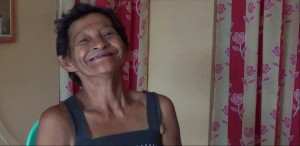Giggling survivor finds her new home beautiful
(8th of a series)
TACLOBAN CITY, Philippines—The wide toothless grin and deep wrinkles betray Leticia Rigaton’s age. But the 58-year-old woman still giggles like a teenager.
When told that she did not seem like someone who survived Super Typhoon “Yolanda,” the most powerful cyclone to ever make landfall in recorded history, she laughed and placed both hands around her face to cover her blushing face.
“That’s just the way I am,” Rigaton said with a smile that lit up her face.
“It’s hard thinking about your past experiences. Yolanda came with the storm surges and my children almost died,” Rigaton recalled.
Article continues after this advertisementRigaton’s house was washed away by the storm surge that Yolanda—international name “Haiyan”—generated when it slammed across the Visayas on Nov. 8, 2013, and they had to make their way to the second floor of the barangay hall by clinging onto snapped electric wires amid neck-deep waters.
Article continues after this advertisementThey were eventually told to leave the barangay (village) hall. They then proceeded to a church, but they did not stay there long either and eventually returned to their devastated neighborhood.
Child-centered
Rigaton, her husband, three children and one grandchild, are now among the beneficiaries of Plan International’s transitional shelter project in Barangay 62, near Tacloban City Astrodome that became the biggest evacuation center in Yolanda’s immediate aftermath.
The shelters of the child-centered international development organization are being built by local residents trained in plumbing and carpentry.
It takes around 10 days for two plumbers and six carpenters to build one house from raw materials of wood and plywood. They are paid P22,000 for each house they build. The money is split evenly among them.
At least 20 of these transitional shelters have been constructed by the local residents, each one of which can house at least seven people.
Rigaton currently does part-time work as a helper. Her husband makes a living repairing shoes though she admits he cannot do much work anymore because he has pneumonia.
Back to normal
Asked how she felt about the transitional shelters that are mostly made of wood, she said: “Beautiful. We were given a decent, beautiful house.”
“Back then it was like we lost our sanity because we didn’t have a home, we didn’t have any food, we didn’t have any livelihood,” Rigaton said, raising her eyebrows slightly a couple of times as if to say “can you beat that?”
“But now we are finally back to normal,” she grinned as if she had just won an award for regaining a sense of normalcy in her life.
When asked about the thousands of people who lost relatives and loved ones, Rigaton admitted she felt sorry for them and also for the many other victims who say they had yet to receive aid from the Department of Social Welfare and Development.
“We feel sad for those who lost their loved ones. Sometimes I watch people on TV who say they have not yet received money. What will they do if they don’t get assistance?” Rigaton said.
She cited her children as a reason why she retains her optimistic and jovial attitude.
“I don’t want to lose my children. I would prefer that I die rather than my children or my grandchildren,” Rigaton said.
“I am happy because my family is still here with me. We may be able to eat only a little, but it’s OK, as long as we don’t get sick. Right?” she said simply as if it was the most obvious thing in the world.
